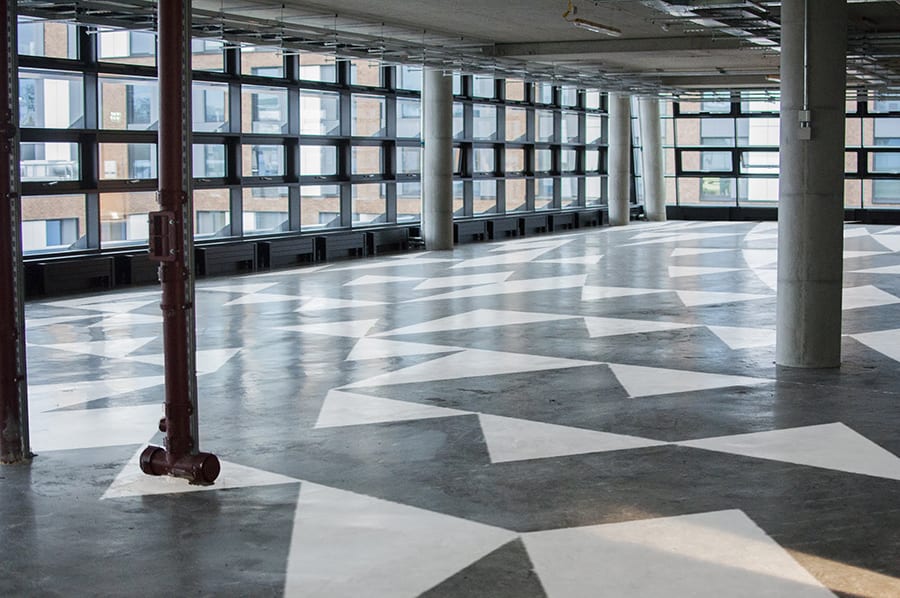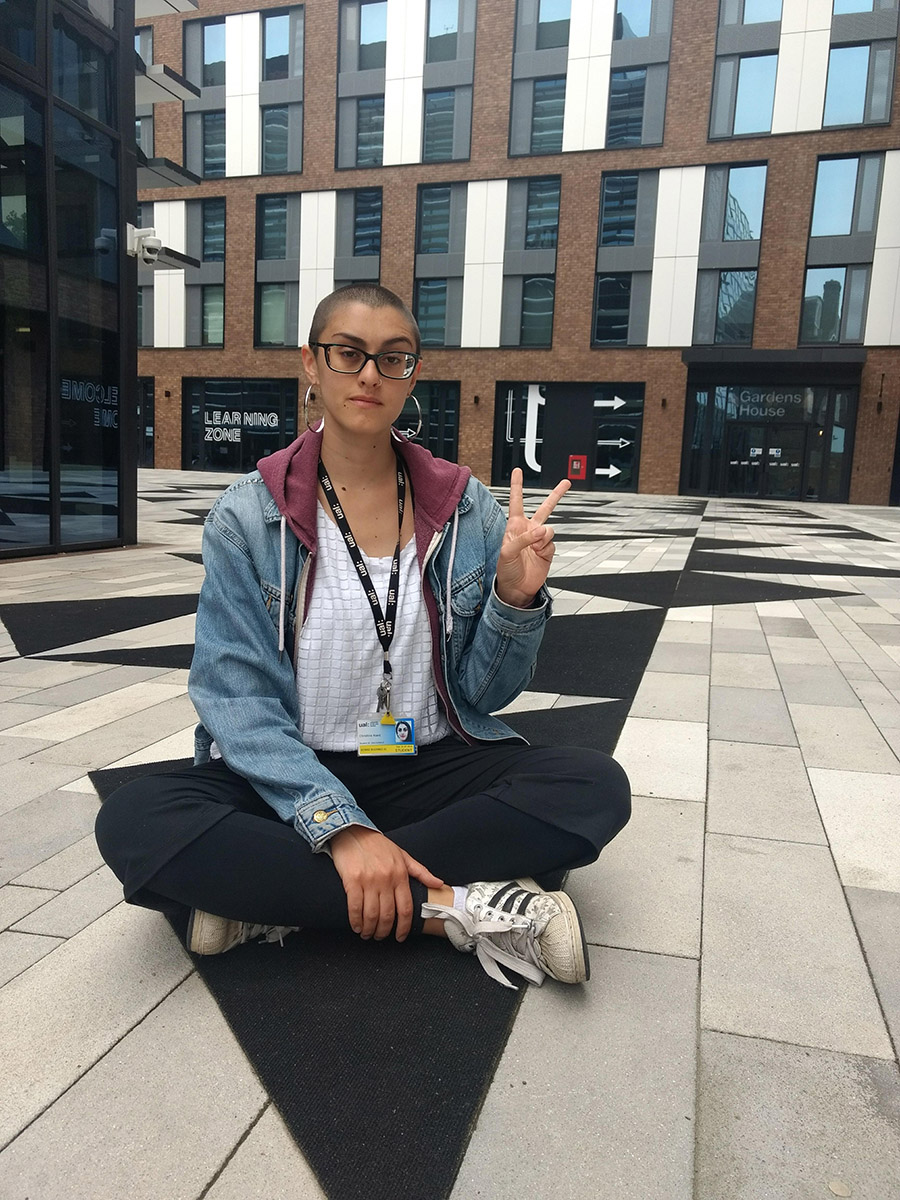Born and raised in Athens BA Drawing student Christina Riant moved to the UK five years ago to work and study art. She is proud of her mixed background, her father is Egyptian-Greek and her mother’s heritage is rooted in Izmir, Turkey, from where her grandmother’s family fled during the war in the early 20th century. Christina is fascinated with mathematics and algorithms and previously studied Management Science and Technology in the Athens University of Economics and Business, focusing on IT business application. We asked Christina about her graduation piece which will be performed next Monday 18 June at the opening of Camberwell Undergraduate Summer Show event.
My practice mostly revolves around researching the common ground between personal, systematic and scientific work.
Because of my information technology background and fascination with mathematics and algorithms, my work appropriates intimate memories of home, family and tradition through seemingly impersonal and rigid mediums, such as programming and Euclidean geometry. I use a variety of materials, from charcoal and sharpies to more unconventional ones, like baking paper, coffee, paper towels and car carpet. I like to use things that normally have a specific role in the domestic space and alter their utilitarian purpose. I mainly work with site-specific installations, manipulating my surroundings and making them communicate with the work. I also create intaglio prints and digital pieces.’
Tell us about your graduation piece
Intersection is an algorithm-drawn site-specific installation and dance performance based on the numerical digits of Goldbach’s conjecture. Goldbach’s conjecture is one of the oldest and best-known unsolved problems in number theory and all of mathematics, and my personal favourite, because of its simplicity: it states that every even integer greater than 2 can be expressed as the sum of two primes.
The work is an attempt to bring together concepts and disciplines that are seemingly distant and create one integral piece of work that is informed by all of them. It consists of a series of numericals assigned to triangular shapes and set next to each other by following an algorithm that dictates their behaviour when adapted to different shapes, similar to the way water behaves in various containers.
The aesthetic of the work has been influenced by German artist Anni Albers’ prints, using an asymmetrical and systematic approach to the creation of the pattern. The floor piece was largely inspired by the idea of geometrical tiled floors in religious buildings and their role in interpreting divine worship. The dance performance, by contemporary dancers and choreographers Miia Mäkilä and Lydia Touliatou, aims to examine physical human behaviour when following the structure of an algorithm, by integrating the improvisational parsing of each line into a repetitive memory-based process.


Where did you draw your inspiration for this piece?
I had visited the Curve Gallery at the Barbican Centre to see ‘material/rearranged/to/be’ by Siobhan Davies and this made me feel very inspired to work with dancers in a way that their performance would be integrated in a Fine Art context. Cross-discipline work, no matter which disciplines it involves, whether it’s an art form like music and dance or something different like science, is of great interest to me because I find that it democratizes the making process, allowing everyone to join in. I guess feeling this way is kind of inevitable, given the majority of my work is algorithm-based, the fact that I was a programming enthusiast when I was younger has irrevocably formed my thinking process.
I constantly think in algorithms, from the moment I wake up to when I organize the series of actions I need to take before I go to bed… it’s a bit paranoid, but I keep catching myself doing it. I tried to break the pattern in my work but it’s just too dominant in my personality, so instead I decided to go with it and enrich it by implementing as many things in the work as possible: memories, ideas, and the human body. I like to observe how human thoughts and actions can be performed in a mechanical or automated way. How we tend to make machines that perform human actions and then try to imitate the machines’ efficiency.
That’s what the choreography is based on, having the performers investigate what it’s like to be an algorithm, repeating a series of actions to perfection. I decided I wanted this piece to be a performative one, because if it wasn’t, it would be just another system. I feel that the dancers’ way of interpreting it is what gives it the ambiguity I am looking for when I make my work. The fine line between machine and human. I am very happy I collaborated with Miia Mäkilä and Lydia Touliatou as it has been extremely educational to observe their research and approach of the concept behind my work. Their performance is absolutely integral to the piece.
Division of labour was key to making this work smoothly and as quickly as possible. When I had a lot of people coming in to help, we each worked on a separate thing. I had a really brilliant team of volunteers to help me. Some days I was just supervising and sticking triangles to the floor, and others I had to do everything on my own, in which case I just focused in one task and waited for someone to show up and help. I find that when working with such limited amount of time you can’t afford to waste a single minute, and that’s what I did. I didn’t stop working until the piece was done, I was so into it I just didn’t even manage to think of anything else during the eight days the installation took place.


What were the steps to create your piece?
That is a long story. I made a drawing about a year ago, and felt like I hadn’t stretched it enough, there was a lot more to be done. I wanted to test how the algorithm behind it would work in different ‘containers’, rather than the conventional rectangle shape – it’s supposed to fill in spaces like water, adapting to any shape. This, wanting to work with the dancers, having a brand new building to play with and wanting to do something rather megalomaniac for the degree show made me thing I wanted to make a floor piece with the dancers performing on it in the new building fourth floor. I communicated my idea to the assistant dean and she suggested we used the courtyard instead. We were really excited, and really-really wanted to make the project happen so we accepted. I reviewed my proposal and re-sent it to be evaluated by the college estates management.
Initially, I was planning to work in vinyl. Vinyl is terrible. It doesn’t stick to stone and it’s slippery when wet. I did some tests with it but the management across the courtyard were not happy with the safety risks around having such a flimsy surface for students to walk on (at this time I didn’t know that the courtyard is something like a no man’s land between the halls and the college) so they rejected my proposal and said that unless I could find a material that didn’t pose a slipping hazard the project was not going to happen. I was panicked.
I revised my proposal and suggested I did the whole thing as a performance, drawing it in charcoal and letting it wash away, and that proposal was rejected. I tried ordering peelable paint from the US, which was simply not affordable, I even ordered liquid latex to mix with black pigment and sand. I randomly noticed the car carpet in a flooring catalogue and thought I’d give that a go, with some heavy duty double sided tape. It worked like a charm – I couldn’t believe the solution to my problem was so simple. I ordered 200m2 of car carpet roll and 1,200m of double sided tape, which was another very complicated process to go through, then finally starting installing!
What made you choose Camberwell College of Arts?
When I decided to study art in the UK, what I aspired to do was still pretty vague in my head. I was very much into classical art and video game design. Drawing being my main skill, I was looking for something that would allow me to expand on that and at the same time help me grow without limiting my options. I was living in London for two years already and was keen on staying here so I applied for several courses. Fine Art Drawing was my first choice, and an option I only found in Camberwell at the time. I remember going to the Open Day when we were split into groups following the various Fine Art Disciplines. I chose to follow the Drawing one where Kelly Chorpening, the course leader, was doing a presentation on the course, and I knew straight away that this is where I wanted to be. I got an offer the day right after my interview and accepted immediately. Best day ever!
Related Links

